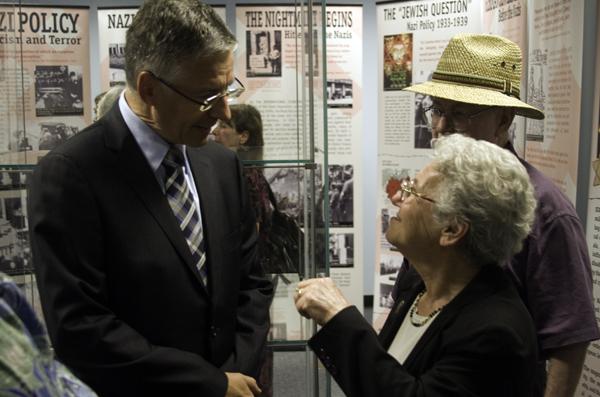Sac State’s ‘Courage to Remember’ portrays Holocaust

Denis Doute, CEO of the Societe Nationale des Chemins de francais, and Holocaust survivor Liz Igra have a conversation within the exhibit shortly after the gallery’s ceremonial opening on Sept. 20.
October 4, 2011
The Holocaust, noted as one of the most notorious genocides to occur in history, has become the subject for Sacramento State’s exhibit in the Anthropology Museum this month.
The exhibit entitled “The Courage to Remember” is running through Nov. 4 in Mendocino Hall, from 10 a.m. to 5 p.m. Tuesday through Friday, and from 1 to 3:30 p.m. Sunday.
On display are more than 200 photographs and historical facts on more than 40 panels, following four major themes: Nazi Germany, 1933-38; Moving Towards the “Final Solution,” 1939-41; Annihilation in Nazi-occupied Europe, 1941-45; and Liberation – Building New Lives.
The exhibit itself is on loan from the Simon Wiesenthal Center’s Museum of Tolerance in Los Angeles and has run in 20 countries on six continents.
“It is a real privilege to host this exhibit,” said museum director Terri Castaneda, associate anthropology professor. “I am so pleased with the number of visitors from the surrounding communities who have already come to see the exhibit, and who have been moved and inspired by its message of tolerance. For me, this is concrete evidence of the exhibit’s value as a tool for the social critique and transformation.”
The exhibit opened on Sept. 20 with guest speakers Liz Igra, a survivor of the Holocaust, Elana Samuels, director of voluntary services in the Museum of Tolerance; Denis Doute of the Societe Nationale des Chemins de fer Francais; America; and Joseph Sheley, provost and vice president of Academic Affairs. Each one gave a speech reflecting on the Holocaust and the pain it inflicted on others all around the world.
“We must have the courage to study, educate and remember the Holocaust,” Samuels said. “Unique interest exhibits provide a hands-on learning experience that inspires visually to learn from the past, engage in the present and inspire for the future.”
Holocaust survivor Ruth Gruber reflected on how the power of the exhibit lies in the fact that it provokes fundamental questions to be asked.
“What it does is make people ask more so they can learn,” Gruber said.
The panels show graphic photographs and tell tales of all kinds of survivors: Jewish people, gypsies, Slavics and the disabled.
“If you follow the panels, you will ask, ‘How is this possible?'” Igra asked during the opening ceremony. “How did normally law-abiding citizens participate in murder, and how did the world turn its head for so long?”
Sac State students have visited the exhibit since its opening, sometimes based on personal ties to the Holocaust.
“My grandfather was in the Holocaust. He was Polish. He was sent to Auschwitz, Buchenwald, and some others. He was there from 1942 to 1945,” said Michael Iwaner, junior criminal justice major. “I really don’t know how I feel. It’s hard to put into words.
During the opening ceremony, Gossett encouraged exhibit viewers to honor those who have survived the tragic events depicted.
Gossett said the survivors are our treasure.
Despite the tragic nature of the events, Doute wished for everyone to be reminded of a quote from Maya Angelou: “History, despite its wrenching pain, cannot be unlived, but if faced with courage, need not be lived again.”
“We need to create awareness,” Igra said. “If there’s one thing to be left with when leaving the exhibit, it’s Samuels’ ending quote – ‘Hope lives when people remember, and we invite you to remember.'”
Kaitlin Bruce can be reached at news@statehornet.com
































































































































